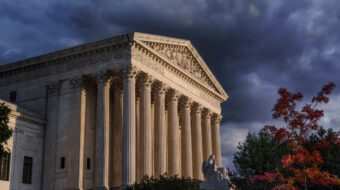News Analysis
Demonstrators from throughout Europe flooded Germany last week to protest the G-8 Summit held June 6-8 in the coastal town of Heiligendamm on the Baltic Sea.
Security measures for the summit, which was attended by leaders of the eight largest world economic and military powers — the United States, Britain, Germany, France, Italy, Japan, Canada and Russia — were overwhelming, and reportedly included the largest massing of armed force in one place in Germany since the Second World War.
In the run-up to the meeting, clashes between riot police and demonstrators were the rule, not the exception. The events in Rostock, June 2, were emblematic, as a 16,000-strong police force took on an estimated 100,000 protestors. What began as peaceful demonstration turned into a skirmish. Over 500 people were injured and many hospitalized. Many protesters were jailed.
The clampdown started weeks before the summit. Repressive actions by the police took place in cities and towns throughout the country. The German authorities carried out “preventive raids” on organizations’ offices, where arrests were made. Biometric data was collected on key activists, including their “scent,” so police dogs could identify them at demonstrations.
At Heiligendamm, demonstrators were kept at least seven miles away from the luxurious hotel where the summit was taking place. At the cost of 12 million euros ($16 million), the authorities constructed a fence to keep protesters out of town. The fence became a poignant symbol of the spending priorities of the powerful and the mighty, and of how little they care for the urgent needs of the rest of humanity.
President Bush and other world leaders were shuttled in by helicopter to the site, so as to avoid coming anywhere close to the demonstrators.
Division and discord characterized the summit, given that many members of the G-8 are currently ensnared in political and economic conflicts, including with each other. Such an embattled climate hasn’t been observed at a G-8 summit since its founding in 1975.
The agenda included world climate changes, Africa, trade, Kosovo, Iran and the Middle East — but not Iraq, so as not to provoke additional conflict. The controversial anti-missile defense shield the U.S. is trying to deploy in Poland and the Czech Republic brought an additional note of tension to the already highly charged summit.
While tensions were lifted somewhat when Russian President Vladimir Putin proposed allowing the U.S. to use a radar system in Azerbaijan, which would cover the entire European continent against a possible missile threat, just one day later his press conference proposal that the U.S. extend the missile shield to Iraq and to Turkey reignited the conflict.
Although summit leaders agreed on the need for a “fundamental reduction” of the emissions which cause the overheating of the planet, they did not all agree on a 50 percent reduction by the year 2050, which was the original proposal of German Chancellor Angela Merkel, supported by Canada, Japan and the European Union. The U.S., which has not even signed the Kyoto accord, stayed its course, refusing to agree to any specific goals.
The G-8 finally committed to $60 billion to combat AIDS, malaria and tuberculosis in Africa. The U.S. will shoulder half the cost. However, one must keep in mind that the 2005 summit, on Tony Blair’s initiative, promised to double the aid to poor African countries by 2010, something that was never acted upon.
Laura Petricola (laurajpetricola@yahoo.com) writes from Athens, Greece.











Comments